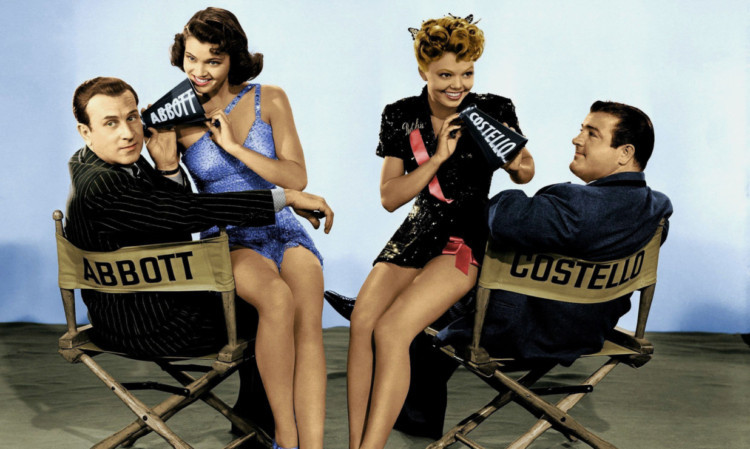
The comedy duo were the biggest stars in the world during the war years.
Not many comedy pairings can claim to have single or should that be double handedly saved a studio. Even fewer can say they physically moved the theatre in which they made their name.
But Abbott and Costello did both. Well, one of them at least.
The first picture they starred in, 1941’s Buck Privates, not only made them huge box-office stars but also saved Universal from imminent bankruptcy.
As for the theatre-moving bit, it’s sort of true.
When cinema chain AMC moved the old Eltinge Burlesque Theatre, where the duo had first teamed up, 168 feet along New York’s famous 42nd Street to its current location, giant balloons of Abbott and Costello were rigged, to appear to pull it.
They were a classic double-act with William “Bud” Abbott as the devious straight man and Lou Costello as the stumbling, dim-witted source of most of the laughs.
Most people know them for their legendary baseball-based routine: “Who’s on first?”, considered one of the greatest routines of all time and which set the template for much of their act.
For the record, Who is on first base, What on second and I Don’t Know on third.
They could vary the length of the routine to fit the circumstances, and it lasted anywhere from a minute to 10 minutes, depending whether they were doing it on stage, TV or for a film.
Abbott and Costello actually born Cristillo weren’t just kings of one format, they were huge hits on the big and small screens, stage and radio.
They’d started out separately in the tough training ground of America’s burlesque theatres.
Burlesque was a form of variety show that grew out of vaudeville, based mainly on ribald comedians telling lewd gags between striptease acts.
If you could hold your own there, you were ready for anything, and Abbott and Costello’s background showed in their slick timing and ability to take anything that was thrown at them.
They also brought something else from their burlesque backgrounds their wives.
Abbott was a veteran, having run his own burlesque touring companies out of Coney Island, usually working as a straight man for his wife Betty, the mother of his four kids.
Costello married the formidably-named Anne Battler and together they adopted two children.
He’d been a comic in the shows since 1930 after failing to make it as an actor, and also spending time as an amateur boxer and stunt man.
He was working for Minsky’s Burlesque shows when he met Abbott in 1935 in New York.
Costello’s regular partner was ill but after they brought the house down, Betty advised her husband to make the accidental pairing a permanent partnership.
They quickly made their way into radio, then lead roles in a Broadway revue.
At first, the similarity in their voices made it hard for audiences to tell them apart, so Lou began to affect a high-pitched childish voice.
It wasn’t long before the movies came calling, Universal Studios signing them to a one-film deal in 1940, and though in supporting roles, they stole One Night In The Tropics by trotting out their well-rehearsed routines, including Who’s On First?
They were snapped up on a long-term contract and Buck Privates was the first of a trio of “service comedies” the pair made before the United States entered the Second World War.
The films saw them “join” every branch of the US armed forces as, after that army romp came In The Navy and Keep ’Em Flying.
The pair starred in no fewer than 36 films together between 1940 and 1956, making them among the most popular and highest-paid entertainers in the world during the war years.
They moved to TV in 1951 as rotating hosts of The Colgate Comedy Hour with Eddie Cantor and Martin and Lewis.
Each was a live hour of vaudeville that saw the pair polish up their old routines, while The Abbott And Costello Show also took the recycling route by transplanting their old radio shows to the small screen.
As is always the case, though, their success was accompanied by a fair share of misfortune, too.
Both were inveterate gamblers and both had health problems Abbott suffering from epilepsy and turning to booze for pain management, and Costello suffering occasional near-fatal bouts of rheumatic fever.
It was on his return to work following a year off with this complaint that Costello lost Lou Jr, his infant son, who drowned in the family swimming pool two days short of his first birthday.
Not long after that came a massive bust-up. They refused to speak to each other apart from when performing when, in 1945, Abbott hired a servant who’d been fired by his partner.
Two films were made in which they were separate characters and not a team before the rift was healed when Abbott volunteered to help with Costello’s charity, a foundation for underprivileged children that still runs today, and suggested naming it the Lou Costello Jr Youth Foundation in tribute to his son.
However, their popularity was waning, partly due to overexposure, so Universal dropped them and the IRS sued them for back taxes, forcing the pair to sell their homes and most of their assets, including the rights to their movies.
When Lou died of a heart attack in 1959 just short of his 53rd birthday, Bud quit show business, apart from doing voices for 156 five-minute Abbott And Costello cartoons made by Hannah-Barbera.
He died of cancer in 1974 aged 78.

Enjoy the convenience of having The Sunday Post delivered as a digital ePaper straight to your smartphone, tablet or computer.
Subscribe for only £5.49 a month and enjoy all the benefits of the printed paper as a digital replica.
Subscribe